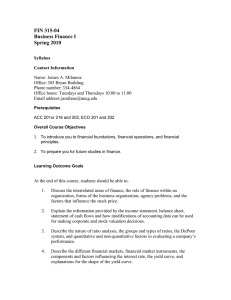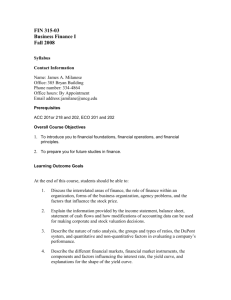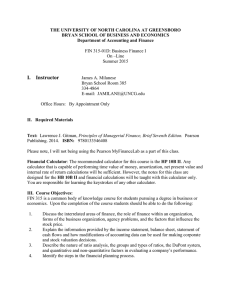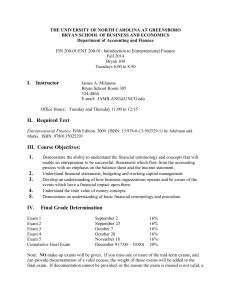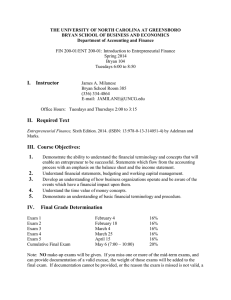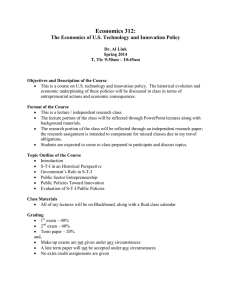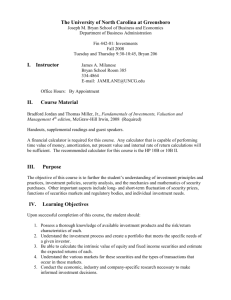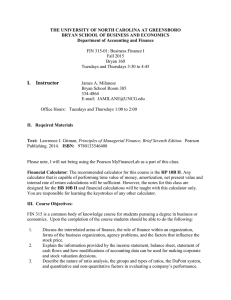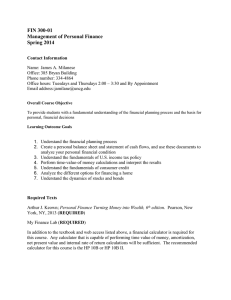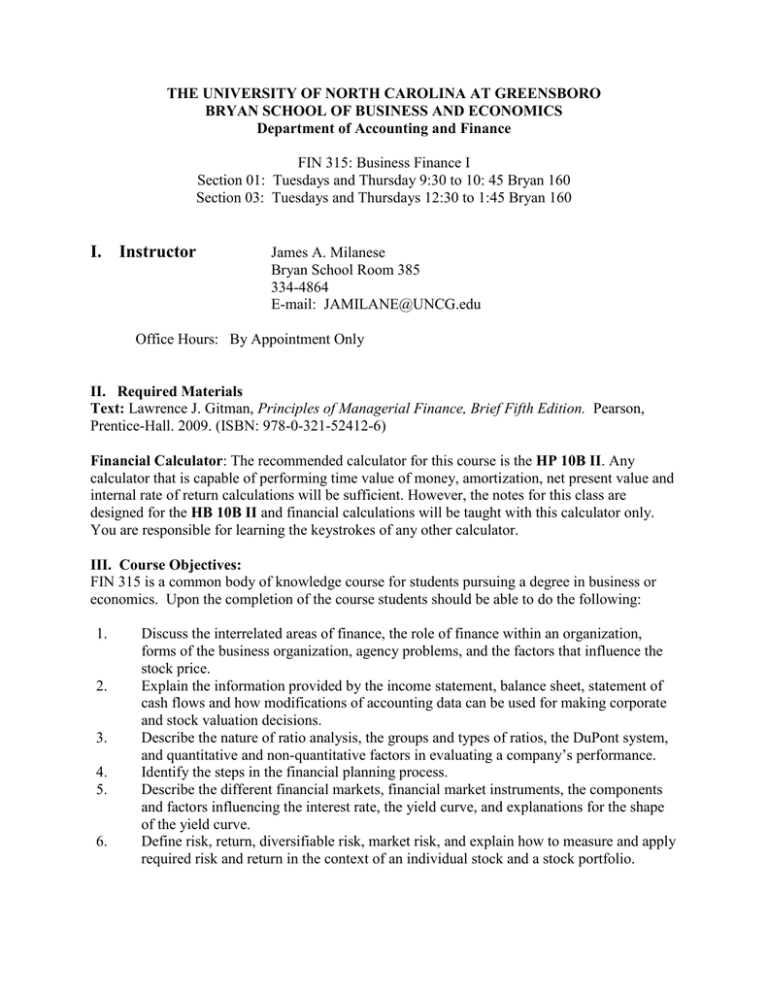
THE UNIVERSITY OF NORTH CAROLINA AT GREENSBORO
BRYAN SCHOOL OF BUSINESS AND ECONOMICS
Department of Accounting and Finance
FIN 315: Business Finance I
Section 01: Tuesdays and Thursday 9:30 to 10: 45 Bryan 160
Section 03: Tuesdays and Thursdays 12:30 to 1:45 Bryan 160
I. Instructor
James A. Milanese
Bryan School Room 385
334-4864
E-mail: JAMILANE@UNCG.edu
Office Hours: By Appointment Only
II. Required Materials
Text: Lawrence J. Gitman, Principles of Managerial Finance, Brief Fifth Edition. Pearson,
Prentice-Hall. 2009. (ISBN: 978-0-321-52412-6)
Financial Calculator: The recommended calculator for this course is the HP 10B II. Any
calculator that is capable of performing time value of money, amortization, net present value and
internal rate of return calculations will be sufficient. However, the notes for this class are
designed for the HB 10B II and financial calculations will be taught with this calculator only.
You are responsible for learning the keystrokes of any other calculator.
III. Course Objectives:
FIN 315 is a common body of knowledge course for students pursuing a degree in business or
economics. Upon the completion of the course students should be able to do the following:
1.
2.
3.
4.
5.
6.
Discuss the interrelated areas of finance, the role of finance within an organization,
forms of the business organization, agency problems, and the factors that influence the
stock price.
Explain the information provided by the income statement, balance sheet, statement of
cash flows and how modifications of accounting data can be used for making corporate
and stock valuation decisions.
Describe the nature of ratio analysis, the groups and types of ratios, the DuPont system,
and quantitative and non-quantitative factors in evaluating a company’s performance.
Identify the steps in the financial planning process.
Describe the different financial markets, financial market instruments, the components
and factors influencing the interest rate, the yield curve, and explanations for the shape
of the yield curve.
Define risk, return, diversifiable risk, market risk, and explain how to measure and apply
required risk and return in the context of an individual stock and a stock portfolio.
7.
8.
9.
10.
11.
IV.
Demonstrate how to find the present and future values of lump sums and annuities, solve
for the time or interest rate in TVM problems, calculate periodic and effective interest
rates, and construct a loan amortization schedule.
List the main classifications and characteristics of bond, calculate bond price and
various bond yields, and explain the importance of bond ratings and criteria for rating
bonds.
Identify important stock ownership rights and terms, how to value common and
preferred stock, and understand stock market information in the newspaper and market
efficiency.
Explain the concept of a firm’s weighted average cost of capital, define and calculate the
component costs of capital using alternative approaches, calculate the weighted average
cost of capital, and identify situations when the use of the composite WACC is not
appropriate.
Explain capital budgeting and steps in the capital budgeting project, methods to evaluate
project financial viability, NPV profiles, the problem of multiple IRRs.
Final Grade Determination
Exam 1
Exam 2
Exam 3
Cumulative Final Exam Section 01
Cumulative Final Exam Section 03
September 14
October 5
November 18
December 9 (8:00 – 11:00)
December 9 (12:00 – 3:00)
25%
25%
25%
25%
25%
Note: NO make-up exams will be given. If you miss one or more of the mid-term exams, and
can provide documentation of a valid excuse, the weight of those exams will be added to the
final exam. If documentation cannot be provided, or the reason the exam is missed is not valid, a
grade of zero will be assigned. For the most part, a valid excuse will be defined as illness, a
death in the family or legal obligation (such as jury duty).
Each exam will be provided to the student for review after grading. Students may not keep the
exams. All exams must be returned to the instructor the same class period they are reviewed
and must not leave the classroom. Failure to return an exam to the instructor will result in a
grade of zero for that exam.
Your final grade will be based on the following scale:
92 – 100
90 – 91.9
88 – 89.9
82 – 87.9
A
AB+
B
80 – 81.9
78 – 79.9
72 – 77.9
70 – 71.9
BC+
C
C-
68 – 69.9
62 – 67.9
60 – 61.9
Below 60
D+
D
DF
The instructor reserves the right to adjust the student’s final grade by a maximum of onehalf point. This adjustment will only be made for students with regular class attendance and
participation.
V.
Topics to be Covered
Chapter 1 The Role and Environment of Managerial Finance
Chapter 2 Financial Statements and Analysis
Chapter 3 Cash Flow and Financial Planning
Chapter 4 Time Value of money
Chapter 5 Risk and Return
Chapter 6 Interest Rates and Bond Valuation
Chapter 7 Stock Valuation
Chapter 9 Capital Budgeting Techniques: Certainty and Risk
Chapter 10 The Cost of Capital
Recommended End-of-Chapter Problems
Chapter
Chapter 1
Problems form the Text you should work
Chapter 1 Required Problems:P1-1, P1-2, P1-3,
P1-6, and P1-9
Chapter 2
Chapter 2 Required Problems: P2-2, P2-3, P26, P2-12, P2-14, P2-18, P2-20 and P2-21
Chapter 3
Chapter 3 Required Problems: P3-1, P3-2, P35, P3-6, P3-7 and P3-8
Chapter 4
Chapter 4 Required Problems: P4-1, P4-2, P44, P4-8, P4-10, P4-11, P4-15, P4-18, P4-19,
P4-29, P4-33, P4-34, P4-47, P4-49, and P4-55
Chapter 5
Chapter 5 Required Problems: P5-1, P5-5, P58, P5-11, P5-17, P5-21, P5-23, P5-24, P5-25
Chapter 6
Chapter 6 Required Problems: P6-1, P6-3, P64, P6-5 (Please assume that the bonds were
issued at par), P6-6, P6-10, P6-14, P6-15, P617, P6-18 and P6-19
Chapter 7
Chapter 7 Required Problems: P7-2, P7-6, P78, P7-9, P7-11, P7-13, P7-16, and P7-19
Chapter 9
Limit to sections 9.1 and 9.2
P9-2, P9-3, P9-5, P9-8, P9-12, P9-14, P9-17
P10-1, P10-2, P10-3, P10-6, P10-8, P10-9,
P10-12, P10-14
Chapter 10
Important: All material in the assigned chapters is “fair game” for test questions, even if not
covered in class lectures. In addition, unless specifically told otherwise, students are responsible
for all lecture material, even if not covered in the text readings.
VI.
Student Disabilities:
All students with a disability requesting special services must go through the Office of
Disabilities Services. If you are requesting special accommodations, please bring your paper
work from Disability Services directly to me the first week of class. All such information will be
help in confidence. The web link to this office is http://ods.dept.uncg.edu/services/ .
VII. Student Conduct
Students are expected to conduct themselves in a professional manner at all times. This means,
but is not limited to:
Arriving for class on time
Doing absolutely nothing during class that is disruptive or detracts from the learning
experience of others
Remaining in class for its duration
Once class begins, the door will be closed. Do not try to enter the room once this has occurred.
Any student disrupting this class will be asked to leave. If the conduct continues, the instructors
reserve the right to drop the student from the class.
For an overview of specific University and Bryan School policies, please see the following
links:
http://studentconduct.uncg.edu/policy/code/
www.uncg.edu/bae/faculty_student_guidelines.pdf
VIII. Honor Policy
All graded material for this class is subject to the UNCG Academic Honor Policy. If you are not
familiar with this policy, please use the following link:
http://www.uncg.edu/reg/Policy/HonorPolicy.html
IX.
Prerequisites
ACC 201 or ACC 218, ECO 201 and ECO 202
Final Note: The last day to drop courses without academic penalty is October 15. The
instructor will not support this course being dropped after this date unless the student provides
written documentation of a valid medical condition that requires withdrawal from all classes.

